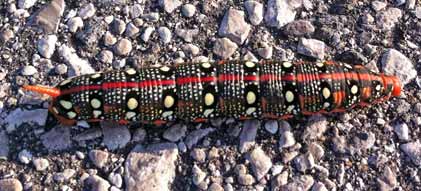Spurge hawk moth found in Michigan
New insects are not always trouble. Sometimes they are welcomed, like the spurge hawk moth.
It may seem that every time a new foreign insect arrives in Michigan we have a new important pest to contend with, but this is not always the case. Our new insect resident, the spurge hawk moth, is actually a welcome addition to the state’s list of insects. It is in the same moth family as some notorious pests such as the tomato hornworm, but the spurge hawk moth is potentially a beneficial insect. It is also a beautiful moth that will thrill gardeners as it flies day or night and sips on flower nectar just like a small hummingbird.


Adult spurge hawk moth (left) and caterpillar of spurge hawk moth (right).
Photo credits: Duke Elsner, MSU Extension (left photo) and Jess Piskor (right photo)
The spurge hawk moth is a European species that is very closely related to our native white-lined sphinx moth. It was intentionally introduced into several western states and Canada specifically for the biological control of an important weed called leafy spurge, which is also native to Europe. The caterpillars of the spurge hawk moth feed on the leaves of leafy spurge, reducing the growth of the plant. It was the first biological control agent to be released for the control of the weed, but it turned out to not be nearly as effective as several beetle species released in later years.
According to Michigan State University Extension, the first recorded specimen of the spurge hawk moth in Michigan was an adult moth caught in Grand Traverse County on June 10, 2013 by myself. A little over a month later, a photograph of a full-grown caterpillar found in Leelanau County was submitted to me. This prompted an investigation of a known patch of leafy spurge west of Traverse City; no caterpillars were found, but almost all of the plants were leafless! A second generation of adult moths appeared in the Grand Traverse region starting in early August.
How fast the spurge hawk moth will spread to other parts of Michigan is impossible to predict. It may have been in the state for a number of years or be more widespread in distribution, perhaps going unnoticed due to the similarity of the adults and caterpillars to the common and widespread white-line sphinx.



 Print
Print Email
Email


